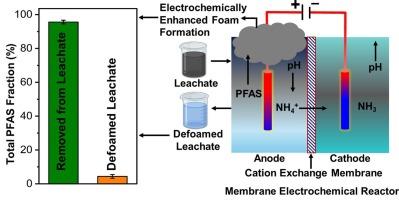膜电化学反应器泡沫分馏垃圾渗滤液中PFAS的研究。
IF 7.1
2区 环境科学与生态学
Q1 ENGINEERING, ENVIRONMENTAL
引用次数: 0
摘要
从化学复杂的垃圾填埋场渗滤液中有效去除PFAS仍然是固体废物工业面临的重大挑战。为了解决这个问题,研究了膜电化学反应器(MER)在阳极室低pH(~ 2.0)下从垃圾渗滤液中去除PFAS的方法。在运行的7小时内,垃圾填埋场渗滤液中PFAS的去除率达到95.6% %,全氟磺酸(PFSA)的去除率为98.3% %,全氟羧酸(PFCA)的去除率为85.5% %。短链pfsa (C ≤ 6,92.5 -99.1 %)的去除率高于PFCAs (C ≤ 6,80.8 -90 %),这可能是由于它们对空气-水界面的亲和力更强,从而增强了泡沫基分离。长链PFAS (C > 6)几乎完全去除(96.1-100 %)。重要的是,PFAS前体如氟端聚体羧酸和全氟烷烃磺酰氟在消泡渗滤液中未被检测到,这表明它们通过氧化转化和MER中的泡沫相分配被去除。使用浓H2SO4将pH调整到2.0,与MER进行比较,结果显示,83.1 %的PFAS分离成泡沫,11.3 %的PFAS分离成沉淀固体。此外,短链PFAS分离为泡沫(59.2-84.7 %)和沉淀固体(5.7-13 %),长链PFAS分离为泡沫(78.3-86 %)和沉淀固体(5.3-18.2 %)。在pH调整前加入0.1 M NaHCO3促进了泡沫的形成,使泡沫中PFAS的分离率提高到92.5 %。该研究强调了MER在不产生任何固体沉淀的情况下有效去除PFAS的性能。进一步的研究应探讨MER操作条件和渗滤液- pfas化学对处理性能的影响。本文章由计算机程序翻译,如有差异,请以英文原文为准。

Foam fractionation of PFAS from landfill leachate using a membrane electrochemical reactor
The effective removal of PFAS from chemically complex landfill leachate remains a significant challenge for the solid waste industry. To address this, a membrane electrochemical reactor (MER) was investigated for PFAS removal from landfill leachate at low pH (∼2.0) in the anode chamber. The MER achieved 95.6 % PFAS removal from landfill leachate within seven hours of operation, with 98.3 % of perfluorosulfonic acids (PFSA) and 85.5 % of perfluorocarboxylic acids (PFCA) removed from the leachate. Short-chain PFSAs (C ≤ 6, 92.5–99.1 %) were removed more efficiently than PFCAs (C ≤ 6, 80.8–90 %), possibly due to their stronger affinity for the air–water interface, which enhanced foam-based separation. Long-chain PFAS (C > 6) showed near-complete removal (96.1–100 %). Importantly, PFAS precursors such as fluorotelomer carboxylic acids and perfluoroalkane sulfonyl fluorides were not detected in defoamed leachate, suggesting their removal through both oxidative transformation and foam-phase partitioning in the MER. Simple pH adjustment to 2.0 using concentrated H2SO4, conducted for comparison with the MER, resulted in 83.1 % of PFAS separation into foam and 11.3 % into settled solids. Additionally, short-chain PFAS were separated into foam (59.2–84.7 %) and settled solids (5.7–13 %), while long-chain PFAS showed similar trends with 78.3–86 % in foam and 5.3–18.2 % in settled solids. The addition of 0.1 M NaHCO3 before pH adjustment enhanced foam formation, increasing PFAS separation in foam to 92.5 %. This study highlights MER’s effective PFAS removal performance without any solid precipitate generation. Further research should explore the effect of MER operational conditions and leachate–PFAS chemistry on the treatment performance.
求助全文
通过发布文献求助,成功后即可免费获取论文全文。
去求助
来源期刊

Waste management
环境科学-工程:环境
CiteScore
15.60
自引率
6.20%
发文量
492
审稿时长
39 days
期刊介绍:
Waste Management is devoted to the presentation and discussion of information on solid wastes,it covers the entire lifecycle of solid. wastes.
Scope:
Addresses solid wastes in both industrialized and economically developing countries
Covers various types of solid wastes, including:
Municipal (e.g., residential, institutional, commercial, light industrial)
Agricultural
Special (e.g., C and D, healthcare, household hazardous wastes, sewage sludge)
 求助内容:
求助内容: 应助结果提醒方式:
应助结果提醒方式:


